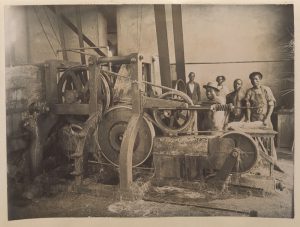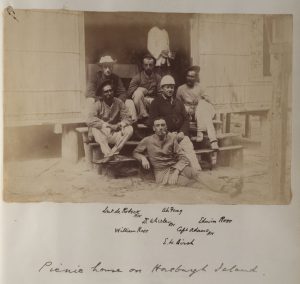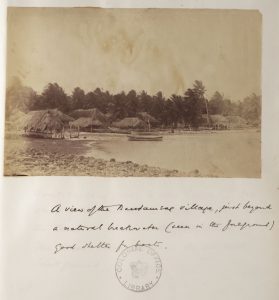
The post below is made on behalf of Ed Thompson, who is undertaking an MA in Modern History at King’s. From January to April 2019, Ed undertook an internship in the Foyle Special Collections Library, in which he researched early photographic representations of the British Empire in the late 19th and early 20th centuries.
An online exhibition showcasing Ed’s work is available here
By Ed Thompson
In a recent piece for the London review of books, Susan Pederson, Professor of History at Columbia University, has claimed that archival research acts as ‘the foundation for most breakthroughs in the field of history.’ Whilst my project does not claim to provide any significant ‘breakthroughs,’ having the opportunity to spend 100 hours amongst primary material gets to the heart of what it means to be a historian.
My time in the Foyle Special Collections Library has predominantly been spent collating and researching photographs of the British Empire contained within the Foreign, Commonwealth and Development Office (FCDO) historical collection. Before its acquisition by King’s in 2007, the collection acted as a library for consultation by the staff of the FCO and its former associated offices of government and was described by Gladstone’s Foreign Minister, Lord Granville, as the ‘pivot on which the whole machinery of the Office turned.’
This internship has been exciting, novel and fascinating, with the potential to take my first foray into co-curating an exhibition presenting a challenging but engaging task.
The scope of the collection
The wide scope of the collection has brought me into contact with official documents and reports ranging from A collection of 1937 coronation celebration documents, which includes a programme of the first broadcast football match in Accra, now capital of Ghana and photographic representations of places like Cyprus and Hong Kong, to a work on Togolese Sisal hemp manufacture. Indeed, the materials remained in the process of being catalogued throughout my time, with new items of relevance being added to the catalogue on a weekly basis.
It has introduced me to both broad themes of colonial history and specific (at-times idiosyncratic) narratives and individuals. It can be easy to lose sight of individual tales given the size and depth of the British imperial project. Yet these tales can enlighten empire-wide themes, often hierarchical and profit-driven in nature and mostly presented through official reports.

EW Birch’s 1885 Report on the Cocos-Keeling Islands is an example. The Islands, situated in the Indian Ocean and now an external territory of Australia, became a formal part of the British Empire in 1857. Before this, from 1820, the Scottish Clunie-Ross family ruled the island as self-styled ‘kings,’ and continued to dominate the island until its sale to Australia in 1978.
The family enforced a racial and patrimonial hierarchy upon the indigenous peoples of the islands and Bantamese immigrants from Java. Whilst they had also appealed to the British government for the installation of a telegraph cable to connect them to the wider world, the seclusion of the Isands was almost absolute.
In the photographs from the report, Birch and his photographer Adams appeared to get along well with the Clunie-Ross family, who themselves had been educated amongst the British elite at Eton and Oxford.

In this one unexpected example, the colonising behaviour of the British is put into view. Perceived European racial superiority was established as legal and economic realities, with the hierarchy revolving around the Clunie-Ross family. More than anything, it evidenced that the imperial project was as much a private enterprise as it was state-based.
For Birch, a government agent, photography presented a good medium through which he could visually exhibit this unfamiliar and remarkable territory.
The age of empire
The period described by Eric Hobsbawm as ‘the Age of Empire,’ (1875-1914) coincided with the rise and proliferation of photographic technology and, as one might expect, photography became more common in reports towards the beginning of the Second World War.
Hence, my project has brought me into contact with a wider field of theoretical discussion on the photograph, particularly in the colonial context. It has been particularly interesting to question the purpose and unspoken undertones in photographs of the period, an exercise which can reveal a great deal about the cultural processes that go into the creation of any image.
The collection can also demonstrate the complexities and heterodox nature of the imperial project and its agents. Therefore, my exhibition attempts to highlight as much of the full-range of photographic material as possible, covering many different areas and genres which are to be found within.
It is exciting to know that several of the photos included in the exhibition are being presented for the first time outside of their Foreign and Commonwealth Office context. Most of the photos used are originals, taken and stuck into typescript reports to inform officials in London and in governing areas as to the progress (or lack thereof) of varying events or projects in the colonial world.
Insights into the collections
Alongside the exhibition I have been given a fantastic insight into the work here at the Foyle Special Collections Library and have been given introductions to the role of cataloguing and digitisation. The latter has been a crucial part of this process and is of vital importance, in helping to preserve these images for later generations to examine for themselves.
It remains to be said that at times the materials I used were extremely distasteful (and offensive) by modern standards, yet it is imperative that rather than shying away from these sources, historians and indeed the wider public confront Britain’s imperial past and its legacy.
The British Empire remains a large, if often unspoken, influence on British society. Thus, investigating the ways in which colonial territories and subjects were presented is an invaluable exercise in comprehending British colonialism and gives a sense of the processes that have driven the particularities of continuing imperial influence.
As a final note, I would like to extend my thanks to the staff at the Foyle Special Collections Library for their help in directing me through the FCO Historical Collection and, of course, for fetching materials and then digitising most of the photos on display in the online exhibition.
Select bibliography
Eric Hobsbawm. Age of Empire: 1875-1914. London: Abacus, 1987
John Scott Hughes. Kings of the Cocos. London: Methuen, 1950
Susan Pederson. ‘I want to Love it: Eric Hobsbawm: a life in history by Richard J Evans’, London review of books, 41 8 (2019), p.14
James Ryan. Picturing Empire: photography and the geographical imagination. London: Reaktion, 1997
Nick Squires. From our correspondent: the man who lost a ‘coral kingdom’, 7 June 2007[http://news.bbc.co.uk/1/hi/programmes/from_our_own_correspondent/6730047.stm accessed 13 April 2019]